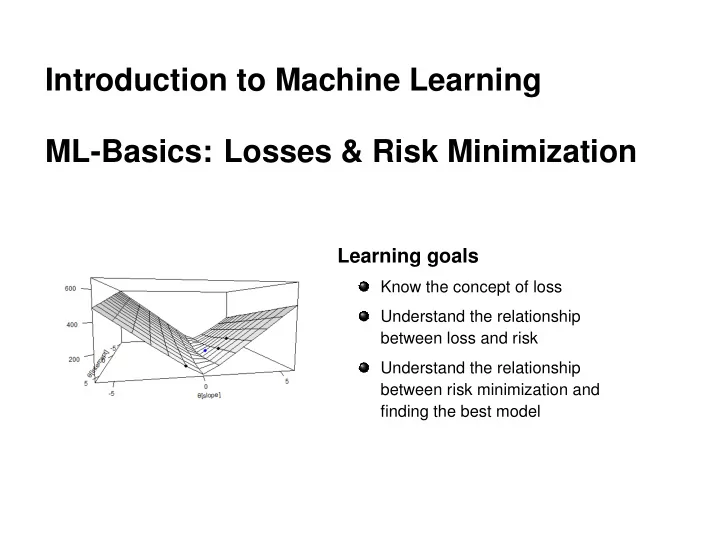

Introduction to Machine Learning ML-Basics: Losses & Risk Minimization Learning goals Know the concept of loss Understand the relationship between loss and risk Understand the relationship between risk minimization and finding the best model
HOW TO EVALUATE MODELS When training a learner, we optimize over our hypothesis space, to find the function which matches our training data best. This means, we are looking for a function, where the predicted output per training point is as close possible to the observed label. To make this precise, we need to define now how we measure the difference between a prediction and a ground truth label pointwise. � c Introduction to Machine Learning – 1 / 9
LOSS The loss function L ( y , f ( x )) quantifies the "quality" of the prediction f ( x ) of a single observation x : L : Y × R g → R . In regression, we could use the absolute loss L ( y , f ( x )) = | f ( x ) − y | ; or the L2-loss L ( y , f ( x )) = ( y − f ( x )) 2 : � c Introduction to Machine Learning – 2 / 9
RISK OF A MODEL The (theoretical) risk associated with a certain hypothesis f ( x ) measured by a loss function L ( y , f ( x )) is the expected loss � R ( f ) := E xy [ L ( y , f ( x ))] = L ( y , f ( x )) d P xy . This is the average error we incur when we use f on data from P xy . Goal in ML: Find a hypothesis f ( x ) ∈ H that minimizes risk. � c Introduction to Machine Learning – 3 / 9
RISK OF A MODEL Problem : Minimizing R ( f ) over f is not feasible: P xy is unknown (otherwise we could use it to construct optimal predictions). We could estimate P xy in non-parametric fashion from the data D , e.g., by kernel density estimation, but this really does not scale to higher dimensions (see “curse of dimensionality”). We can efficiently estimate P xy , if we place rigorous assumptions on its distributional form, and methods like discriminant analysis work exactly this way. But as we have n i.i.d. data points from P xy available we can simply approximate the expected risk by computing it on D . � c Introduction to Machine Learning – 4 / 9
EMPIRICAL RISK To evaluate, how well a given function f matches our training data, we now simply sum-up all f ’s pointwise losses. n � � x ( i ) �� � y ( i ) , f R emp ( f ) = L i = 1 This gives rise to the empirical risk function which allows us to associate one quality score with each of our models, which encodes how well our model fits our training data. R emp : H → R � c Introduction to Machine Learning – 5 / 9
EMPIRICAL RISK The risk can also be defined as an average loss n R emp ( f ) = 1 � � x ( i ) �� ¯ � y ( i ) , f L . n i = 1 The factor 1 n does not make a difference in optimization, so we will consider R emp ( f ) most of the time. Since f is usually defined by parameters θ , this becomes: R : R d → R n � � x ( i ) | θ �� � y ( i ) , f R emp ( θ ) = L i = 1 � c Introduction to Machine Learning – 6 / 9
EMPIRICAL RISK MINIMIZATION The best model is the model with the smallest risk. If we have a finite number of models f , we could simply tabulate them and select the best. Model θ intercept θ slope R emp ( θ ) f 1 2 3 194.62 f 2 3 2 127.12 f 3 6 -1 95.81 f 4 1 1.5 57.96 � c Introduction to Machine Learning – 7 / 9
EMPIRICAL RISK MINIMIZATION But usually H is infinitely large. Instead we can consider the risk surface w.r.t. the parameters θ . (By this I simple mean the visualization of R emp ( θ ) ) R emp ( θ ) : R d → R . R emp ( θ ) Model θ intercept θ slope f 1 2 3 194.62 f 2 3 2 127.12 f 3 6 -1 95.81 f 4 1 1.5 57.96 � c Introduction to Machine Learning – 8 / 9
EMPIRICAL RISK MINIMIZATION Minimizing this surface is called empirical risk minimization (ERM). ˆ θ = arg min R emp ( θ ) . θ ∈ Θ Usually we do this by numerical optimization. R : R d → R . θ intercept θ slope R emp ( θ ) Model f 1 2 3 194.62 f 2 3 2 127.12 6 -1 95.81 f 3 f 4 1 1.5 57.96 f 5 1.25 0.90 23.40 In a certain sense, we have now reduced the problem of learning to numerical parameter optimization . � c Introduction to Machine Learning – 9 / 9
Recommend
More recommend